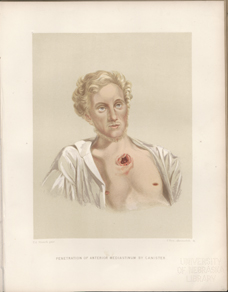Title: Betts, Charles P.
Source text: Surgeon General Joseph K. Barnes, United States Army, The Medical and Surgical History of the War of the Rebellion. (1861–65.), Part 1, Volume 2 (Washington, D.C.: Government Printing Office, 1870), 486-487.
Civil War Washington ID: med.d1e19377
TEI/XML: med.d1e19377.xml
CASE.—Private Charles P. Betts, Co. I, 26th New Jersey Volunteers, aged 22 years, was struck by a three-ounce grapeshot, on the morning of May 3d, 1863, in a charge upon the heights of Fredericksburg. The ball comminuted the sternum, at the level of the third rib, on the left side, and tore through the costal pleura. It remained in the wound and was removed by the patient. On the following day, Betts entered the hospital of the 2d division of the Sixth Corps. Through the wound, the arch of the aorta was distinctly visible, and its pulsations could be counted. The left lung was collapsed. When sitting up there was but slight dyspnœa. Several fragments of the sternum were removed, and the wound soon granulated kindly. On May 10th, a colored drawing of the wound was made.† (No. 19, Surgical Series of Drawings, S. G. O.) On July 5th, the patient was transferred to Washington, convalescent. He ultimately recovered perfectly. This man was discharged the service on June 27th, 1863, and was subsequently pensioned, his disability being rated three-fourths and permanent. On April 5th, 1864, Pension Examiner L. A. Smith reports that the injured lung "still continues defective somewhat, causing dyspnœa." The following is an extract from the patient's letter, dated Newark, New Jersey, April 22, 1872, in reply to an inquiry regarding his condition: "My wound is not what you would call a running sore exactly, but still there is all the while a kind of dry scab forming and coming off one after the other, and it is very tender. I have spoken to several doctors about it, and they say that it will always be so on account of the bone being broken in such a way that it is ragged and does not heal solid. My health is as good as I ever expect it to be again. My left lung is a very delicate thing, and the least cold seems to go right to it, and the weather we have here at this season of the year is very rough on me; but I suppose there is no use of crying over spilt milk, but must only try to make the best of a bad job."
† The drawing was made at the Potomac Creek Hospital of the 2d division, Sixth Corps, and so faithfully was the likeness of the patient preserved, as well as the features of the wound, that Surgeon S. A. Holman, U. S. V., medical director of the Sixth Corps, in 1865, turning over a portfolio at the Surgeon General's Office, and, observing this drawing, exclaimed: "I know that man; that's Betts, 2d division, Sixth Corps!"
